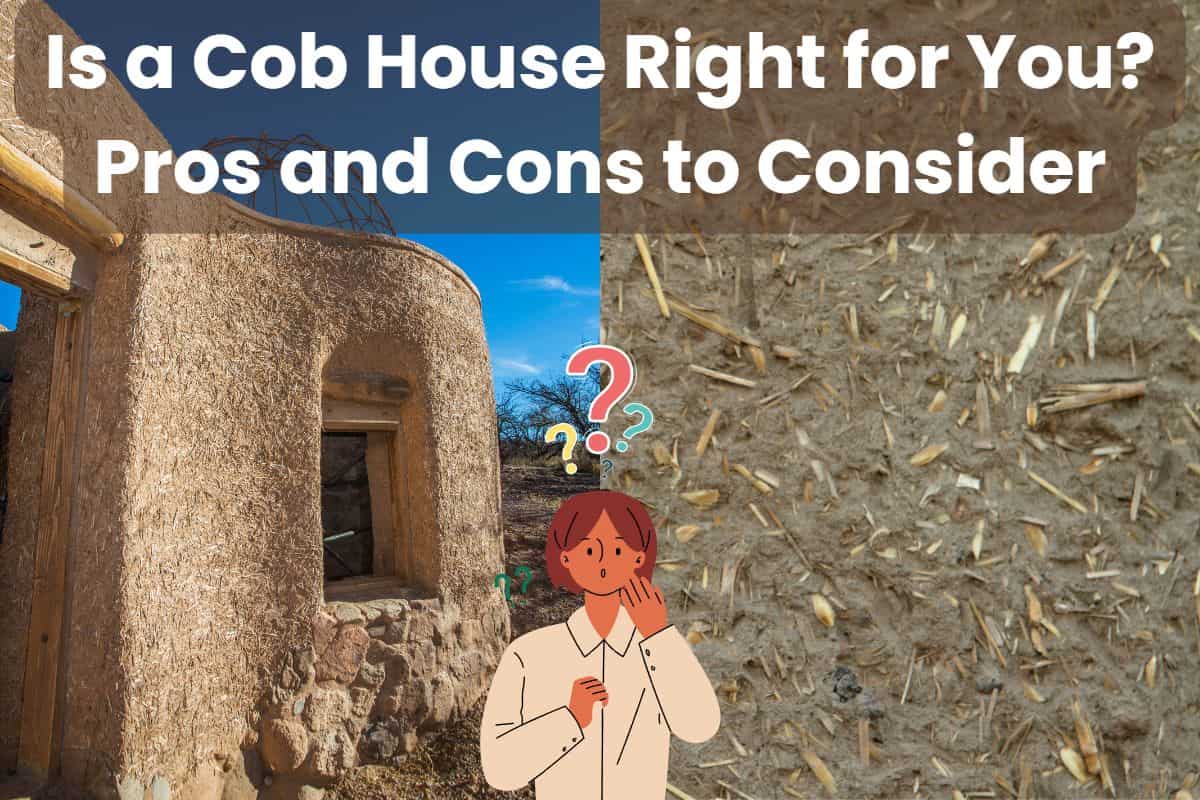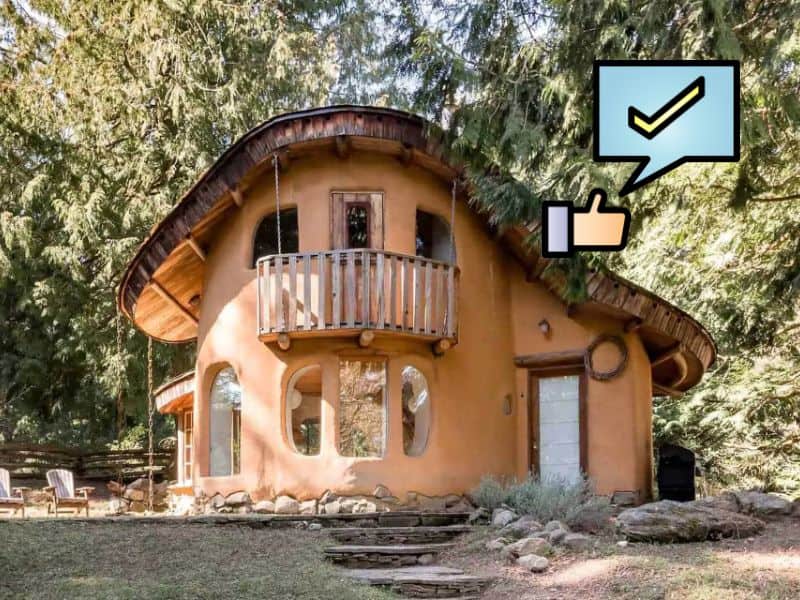Is a Cob House Right for You? Pros and Cons to Consider

The construction industry is changing rapidly as we seek to embrace sustainable construction to combat climate change.
Cob house construction is one of the building techniques that has seen a resurgence in recent years due to its sustainable nature. However, before going that route, is a cob house right for you?
One way to think about this question is to consider the pros and cons of a cob house. While each construction method has drawbacks, you want to ensure that the benefits outweigh the disadvantages for your project.
In this article, I’ll help you understand if a cob house is right for you by discussing the pros and cons of building with this technique. So, let’s dive right in!
The Pros of a Cob House

They Are Inexpensive
The first thing that comes to mind before embarking on any construction project is cost. This is because construction costs have been soaring in recent years due to the high costs of building materials. Remember, building materials account for 70 percent of a project’s cost.
If you’re on a tight budget, a cob house may be your go-to option because they’re inexpensive if you’re willing to roll up your sleeves and do much of the labor yourself.
As the name suggests, a cob house is made from cob, a mixture of clay, sand, silt, gravel, and straw. You can acquire these natural materials freely at the construction site or buy them in bulk cheaply.
Besides the walls, thatching is often used for the roof, which is also very affordable. All in all, cob houses are much more cost-effective compared to other building techniques.
They Are Durable
What is the longevity of cob houses? This is a common question among those considering this building technique.
Well, the answer is simple – cob houses are built to last a lifetime. There are cob houses today that have existed for more than 10,000 years.
Cob is made from mud, a highly porous material that can withstand long periods without weakening, especially with proper maintenance.
That said, it’s worth mentioning that although mud is durable, it’s not waterproof. As a result, cob houses require good roofing and drainage to protect the walls from water damage.
For longevity, ensure that the roofs have long overhangs. A rule of thumb is to install at least 23.62-inch (60-cm) roof overhangs.
Cob Is Strong

Cob houses won’t disappoint when it comes to strength. They are very strong due to the material’s high compressive strength.
Compressive strength is the capacity of a building material to bear compressive loads before failure.
With a compressive strength of 1.29 MPa, cob is a strong material that can withstand heavy loads without failing, so walls made with cob can be load-bearing to support an upper floor or roof.
That said, is cob as strong as concrete?
According to the Cob Cottage Company, cob dries to a hardness similar to lean concrete and withstands considerable pressure.
Excellent Acoustics
Acoustic performance is essential if you’re looking for a quieter home. Sound-proof homes help to keep out external noise for a quieter interior.
Cob walls offer excellent soundproofing and acoustic performance due to the material’s density. The air pockets in cob also help absorb sound waves, resulting in improved acoustic performance.
I’ve heard people ask whether cob houses are susceptible to damp because of the air pockets in their walls, but these pockets don’t make the house damp. In fact, the air pockets make the house breathable, reducing moisture buildup and dampness because they absorb moisture from the inside air and release it outside.
Moreover, due to cob walls’ thickness [18-24 inches (45.72-60.96 cm)], they offer better soundproofing than conventional walls.
High Thermal Mass

Thermal mass is the capacity of a material to absorb and store heat energy during times of high temperature and release it when temperatures are lower.
Thermal mass is directly proportional to specific heat capacity; the higher the thermal mass, the better.
Cob’s high thermal mass is the reason for the material’s high heat capacity averaging 1205 Jkg−1K−1. Therefore, cob walls absorb more heat from the sun and release it at night when temperatures drop.
As such, are cob houses warm? Absolutely!
Cob walls keep the house warm by absorbing solar energy in the daytime and releasing it at night. Consequently, you don’t have to rely so heavily on central heating.
High Sustainability
Due to unsustainable building materials, the construction industry is responsible for 50 percent of climate change.
Luckily, cob is one of the most sustainable building materials available today. The material is extracted from natural resources like clay and straw, making it a very sustainable option.
Cob is also durable, requires fewer resources to maintain, and is non-toxic. Therefore, it contributes to minimal environmental pollution.
Moreover, cob materials like clay and sand are usually sourced locally. Thus, they require minimal transportation, reducing their embodied energy. This explains why, unlike other building materials, cob has a lower embodied energy of 0.065 MJ-eq/kg.
The Cons of a Cob House
Now, what are the disadvantages of cob houses? Let’s see:
It Can Be Hard to Get a Mortgage

One of the common questions we receive from interested parties is, “Can you take out a mortgage on a cob house?
While cob houses are generally fine by most mortgage lenders, securing a mortgage can still be challenging due to insufficient knowledge about this building technique.
Some companies may consider cob houses unconventional dwelling units and may be unwilling to approve mortgages for such houses.
Those who approve cob house mortgages may levy high rates of interest to cushion themselves against the risks of unconventional materials and building technology. You might also be required to put down a larger deposit to meet stricter loan-to-value requirements.
Therefore, it’s crucial to consult a financial advisor before applying for a cob house mortgage.
They Are Labor-Intensive and Time-Consuming
If you’re strapped for time, a cob house might not be your best bet.
One of the biggest downsides of cob houses is that they need a lot of labor and time to build.
Cob houses are built in courses and layers. For a sturdy and durable wall, each layer must dry completely before moving to the next.
The waiting time for each layer to dry can take two to four weeks. This means cob houses require more time than traditional houses, making them unsuitable for those on a tight timeline.
Moreover, cob houses are labor-intensive due to the following activities:
- Digging and excavating foundations.
- Mixing the cob material.
- Molding, shaping, and packing it into walls.
- Applying surface finishes to create a smooth finish.
These activities are laborious and require a great deal of elbow grease.

Poor Thermal Insulation
I’ll be realistic with you; although cob has a high thermal mass, it’s non-insulative due to its low R-value.
Cob has an R-value of 0.22 per inch of thickness. This is a low value, meaning cob walls have a low resistance to heat flow.
Therefore, cob houses are not ideal in areas with extreme temperatures.
If you must build a cob house in an area with extreme temperatures, you must insulate the walls with material like fiberglass or sheep’s wool. If you don’t do that, you’ll need to be ready to dig deeper into your pockets to pay high energy bills due to constant heating requirements.
It Can Be Hard to Get Permits
In many countries, the authorities do not readily approve alternative building methods like cob. Therefore, getting permits and financing for your cob building project can be hard.
With that in mind, it’s crucial to consult relevant local government bodies and agencies before embarking on a cob house construction project. Otherwise, you might find yourself in a tight corner after completing the entire process without the necessary approvals.
So, Is a Cob House Right for You?
A cob house is right for you if you want a cost-effective, durable, and sustainable building option.
However, remember that cob construction is labor-intensive and time-consuming.
Furthermore, depending on your location, getting permits and financing can be challenging. So, consider all these factors before making your decision.
Most importantly, consult a financial advisor and relevant local government agencies to be fully informed.
Before you leave, check out these other ten sustainable construction methods to build with.







